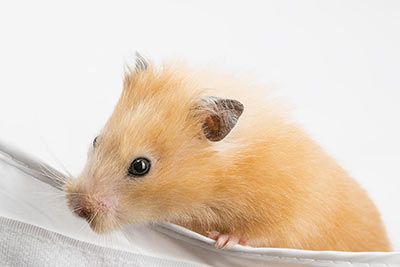Banded Syrian Hamster
Banded Syrian Hamster Breed Profile
| Origin | Syria, Turkey |
| Genus | Mesocricetus |
| Scientific name | Mesocricetus auratus |
| Size | 4.8 to 6.2 inches (12-16 cm) |
| Color | All colors possible; white band around the body |
| Lifespan | 1.5 to 2 years |
| Personality | Usually placid, robust |
| How to keep them | Separately |

Characteristics
Banded hamsters aren’t a special species, just Syrian hamsters with an especially bred coat featuring a certain pattern. Their name refers to the band of white fur around them. This band goes all around the body like a life preserver.
Hamster fans especially prize hamsters that have bands that are around 1/3 as wide as the animal’s body length. It should ideally be the same thickness all the way around and have no gaps. The straighter it is and the more cleanly defined the line is between the fur colors the better for many owners. Of course, this isn’t always the case as nature is very creative and doesn’t like sticking to clear, strict rules. So you’ll often see banded hamsters with zigzag, broken and/or narrower/wider bands. And let’s be honest: does that make the hamster any less lovable? It’s exactly these quirks that make a personality more interesting!
Banded Syrian hamsters come in all colors - apart from their bands - and can even be multi-colored e.g. black and brown.
Personality
Banded Syrian hamsters are considered docile and calm.
History
The white band is passed on when at least one parent has a white band. The gene is recessive, so it cannot compete with other, dominant (stronger) genes. Did you know that all of that these hereditary differences have their own codes? The code for the band is BaBa, Baba or Ba. Cinnamon is pp, black is aa and long fur is ll. So if someone says they have a “ba pp aa ll” hamster, you can tell it’s a banded hamster with long fur in black and cinnamon without even seeing it. It’s almost like a secret language!
Breeding Fur Colors
It might be tempting to breed hamsters to create amazing or rare colors and patterns. But if you don’t know what you’re doing, you could end up breeding hamsters whose genes don’t work well together. The result? The baby hamsters can’t survive. It takes a lot of experience, so anyone that isn’t a breeder should stay clear.
Fun Facts
Banded Syrian hamsters have existed since 1957.











